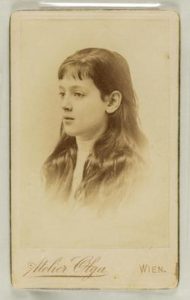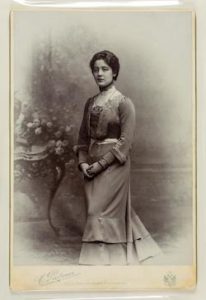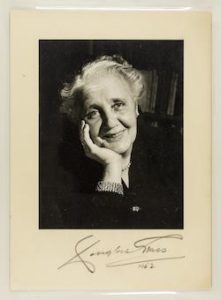
Roger Amos is a retired doctor, in a previous life a haematologist working in the NHS in east London. His wife, Anne, is a psychoanalyst and a member of the British Psychoanalytical Society. He has lived on the fringes of the analytic world for many years, where Melanie Klein has been an abiding presence. His book, Portrait of a Life: Melanie Klein and the Artists, has been an opportunity to get to know her better.
 How can we know another person, understand their feelings, enter their world? Is that even possible or desirable? For individuals from the past, the problem is multiplied manyfold. To be sure, we have their own writings, what others said and wrote about them, letters received and sent, accounts of their relationships with others, but this word-based understanding has its own limitations and can often seem two-dimensional and limited in scope. The innovative psychoanalyst Melanie Klein was famously reticent about her past, destroying virtually all of the correspondence she received and often unclear about the details of her private life, both perhaps to protect her patients but also to shield herself from the prying eyes of bourgeois morality. In addition, she was also, by all accounts, a difficult character to describe or define; to some humourless and dogmatic, to others vital and affectionate, she polarised opinion not only in her ideas and theories but also in her person.
How can we know another person, understand their feelings, enter their world? Is that even possible or desirable? For individuals from the past, the problem is multiplied manyfold. To be sure, we have their own writings, what others said and wrote about them, letters received and sent, accounts of their relationships with others, but this word-based understanding has its own limitations and can often seem two-dimensional and limited in scope. The innovative psychoanalyst Melanie Klein was famously reticent about her past, destroying virtually all of the correspondence she received and often unclear about the details of her private life, both perhaps to protect her patients but also to shield herself from the prying eyes of bourgeois morality. In addition, she was also, by all accounts, a difficult character to describe or define; to some humourless and dogmatic, to others vital and affectionate, she polarised opinion not only in her ideas and theories but also in her person.
 Married to a psychoanalyst, Melanie Klein has been a constant presence in the background of my life, like a shadow on a wall mutable and fluid, at different times sharp or ill-defined, moving and altering shape, depending on the strength and angle of the light; associated in my mind with obscure and mildly threatening words – part-objects, splitting, projective identification, schizoid – although it is true other words had a warmer, more humane quality – love, guilt and reparation, loneliness, the depressive position. Her only biographer, Phyllis Grosskurth, was also conflicted. Despite sometimes being harsh and unforgiving in her judgements she nevertheless clearly articulates the persecution that Klein endured during her life as well as after her death and the terrible toll exacted on her by the losses in her early life; the struggle by a woman with no formal education for professional acceptance; her sometimes brutal honesty and her total devotion to her work and ideas.
Married to a psychoanalyst, Melanie Klein has been a constant presence in the background of my life, like a shadow on a wall mutable and fluid, at different times sharp or ill-defined, moving and altering shape, depending on the strength and angle of the light; associated in my mind with obscure and mildly threatening words – part-objects, splitting, projective identification, schizoid – although it is true other words had a warmer, more humane quality – love, guilt and reparation, loneliness, the depressive position. Her only biographer, Phyllis Grosskurth, was also conflicted. Despite sometimes being harsh and unforgiving in her judgements she nevertheless clearly articulates the persecution that Klein endured during her life as well as after her death and the terrible toll exacted on her by the losses in her early life; the struggle by a woman with no formal education for professional acceptance; her sometimes brutal honesty and her total devotion to her work and ideas.
But it was the pictures of Klein – as sister, mother, psychoanalyst – spanning her life from a young woman to an old lady; the portrait photographs, paintings, and sculptures, and the stories behind them, which for me really brought this elusive woman to life. Looking and thinking about these pictures in the context of her life history, trying to place them in the word narrative of her life illuminated both the pictures and the story. Bringing to life the struggle with depression in her early years, the failure of her ill-advised marriage and her pain and joy at being a mother and grandmother.
 But perhaps most significantly it was the relationship between Klein and the artists themselves, which often threw the most light onto the subject, bringing the shadows into sharp focus, revealing unexpected subtleties and connections. The artist, particularly the photographer, is often lost sight of in these brief encounters, but what they bring from their own life will have a profound influence on how they choose to see us; the setting in which we are placed, how the face is lit, the colour and weight of line used. Trust and empathy are essential elements of this relationship if it is to be creatively successful and it is perhaps hardly surprising that it was the women artists, often mothers themselves with difficult and painful relationships with their own mothers, who were to produce some of the most sympathetic and endearing portraits of Klein. They recognized, at some level, Klein’s own suffering following the devastating death of her son Hans and the permanent estrangement from her daughter Melitta and how she strove throughout her life to redeem these losses through her devotion to her patients and to her grandchildren and by the vigorous way in which she defended her work and her legacy.
But perhaps most significantly it was the relationship between Klein and the artists themselves, which often threw the most light onto the subject, bringing the shadows into sharp focus, revealing unexpected subtleties and connections. The artist, particularly the photographer, is often lost sight of in these brief encounters, but what they bring from their own life will have a profound influence on how they choose to see us; the setting in which we are placed, how the face is lit, the colour and weight of line used. Trust and empathy are essential elements of this relationship if it is to be creatively successful and it is perhaps hardly surprising that it was the women artists, often mothers themselves with difficult and painful relationships with their own mothers, who were to produce some of the most sympathetic and endearing portraits of Klein. They recognized, at some level, Klein’s own suffering following the devastating death of her son Hans and the permanent estrangement from her daughter Melitta and how she strove throughout her life to redeem these losses through her devotion to her patients and to her grandchildren and by the vigorous way in which she defended her work and her legacy.
 No one picture, however great, can encompass a life but the many representations of Klein which have come down to us can only help to enhance our understanding of her as an individual adding warmth and humanity to the sparse literary narrative. For me, Melanie Klein emerges from these portraits as a woman of exemplary courage; she endured loss and depression but used these in a creative way to inform her work and despite often being lonely and isolated, she was able to transcend this and remained to the end of her life affectionate and pre-eminent in her enjoyment of people.
No one picture, however great, can encompass a life but the many representations of Klein which have come down to us can only help to enhance our understanding of her as an individual adding warmth and humanity to the sparse literary narrative. For me, Melanie Klein emerges from these portraits as a woman of exemplary courage; she endured loss and depression but used these in a creative way to inform her work and despite often being lonely and isolated, she was able to transcend this and remained to the end of her life affectionate and pre-eminent in her enjoyment of people.
Roger Amos
